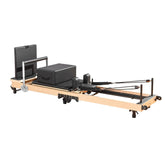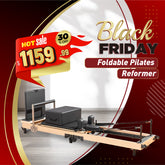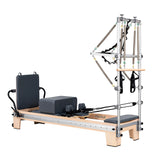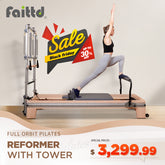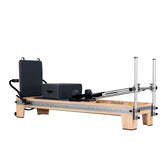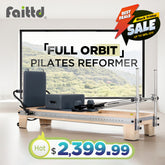Do I Need Special Clothing or Equipment to Work Out on a Pilates Reformer?
No, you don't need anything fancy—just form-fitting clothing that won't get caught in the machine and some grip socks to keep you stable. Consider leggings or tight shorts, a snug top that won't ride up as you move, and those special socks with rubber spots on the bottom (or wear barefoot if you want). Remove any jewelry or loose clothing that may become caught in the spring, and you're good to go!
Key Takeaways
- Tight clothing allows for easy movement and helps teachers see your posture.
- Use grip socks for greater balance on the Reformer and avoid slippery socks for safety.
- Choose elastic and breezy fabrics to stay comfortable and cool throughout the exercise.
What to Wear to Reformer Pilates
1. Form-Fitting Clothes
When it comes to reforermer Pilates, form-fitting clothes are your best friend. They don't just make you look the part-they actually help you perform better. Tight-fitting tops and leggings allow you to move freely without fabric getting in the way. Plus, your instructor can easily check your alignment and posture, which is crucial for avoiding injuries.
An outfit that fits will keep you safe and make you pay more attention to your session on the Pilates reformer.
Bonus tip: find tops with built-in support for keeping everything in place while you move.
2. Grip Socks
Reformer Pilates, however, calls for grip socks—a need rather than a fashion statement. These socks provide the traction required to keep you on the machine, as otherwise, especially on those balanced motions, your feet could slip.
3. Breathable and Stretchable Fabrics
For Pilates reformers, the perfect attire is lightweight and composed of flexible fibers. Perfect materials are blends of polyester or nylon since they chill you and help you wick away sweat. Steer clear of non-breathable materials as they trap heat and could cause discomfort.
Following are some key things to look for in your Pilates attire:
- Fabrics that promote airflow to prevent overheating.
- Stretchy materials like spandex blends for unrestricted movement.
- Lightweight athletic gear akin to a second skin.
You won't enjoy your Pilates session if your clothes feel uncomfortable. Choose garments that suit you, stretch with your motions, and keep you cool. Keep to the appropriate clothing—form-fitting, airy, and supporting. It's a minor adjustment with great impact.

What to Avoid in Reformer Pilates
1. Loose or Baggy Clothing
Baggy clothes might seem cozy, but they’re a big no-no for Pilates reformer workouts. Why? They can get caught in the springs, straps, or other parts of the machine. This isn’t just annoying—it’s dangerous.
Here’s a quick breakdown of the risks:
| Clothing Type | Risk Description |
| Loose Clothing | Can get caught in springs or straps, leading to potential injuries. |
| Baggy Clothes | Generally uncomfortable and pose a safety hazard during workouts. |
- Avoid anything that hangs or drapes too much.
- Stick to form-fitting clothes that let you move freely without snagging.
You’ll feel more confident and focused when you’re not worrying about your outfit getting in the way.
2. Slippery Socks or Bare Feet
Regular socks may be good enough, but they will turn the workout into a slip-and-slide. Slippery socks don't give you the needed grip on the Reformer, which is unsafe.
Grip socks are your best bet. They give you traction and stability, especially in moves with plenty of balancing. If you prefer going barefoot, that's fine too. Bare feet help you connect with the Reformer platform and engage your muscles better.
Here’s the deal:
- Grip socks = stability and safety.
- Bare feet = better muscle engagement.
- Regular socks = risky business.
Choose what works for you, but skip the slippery socks to avoid accidents.
3. Jewelry That Can Interfere
Jewelry may look fabulous, but it does not belong in a Pilates studio. Necklaces, bracelets, and rings may get in the way of your movements. Worse, they may damage the equipment or even hurt you.
Keep it simple:
- Leave dangling or bulky jewelry at home.
- Avoid anything that could snag or interfere with your workout.
By keeping your accessories minimal, you’ll stay focused and safe during your session.
4. Avoiding Restrictions
Baggy pants like sweatpants catch on the machine and stop you from moving freely, so avoid them entirely. High-waisted leggings are your best option; they stay in place during exercises and provide good support when you lie down. Avoiding Restrictions
Essential Equipment for Pilates Reformer
1. The Reformer Itself
The Pilates reformer machine is a versatile piece of Pilates equipment that transforms your workout. Whether you’re a beginner or a pro, this machine adapts to your needs.

2. Additional Accessories
Want to take your reformer machine workouts to the next level? Add some Pilates accessories. These extras enhance your routine and keep things fresh:
- Resistance bands
- Stability balls
- Foam rollers
- Ankle weights
- Pilates rings
Each of these tools complements the reformer, giving you more ways to target specific muscle groups and improve your overall performance.
3. Resistance Bands
Want to kick your reformer workout up a notch? Try adding resistance bands! These simple, stretchy tools pack a serious punch. They're super light and easy to bring along, but don't let that fool you—they can really amp up your workout.
Here's what makes them so great:
- They make your regular moves more challenging (in a good way!)
- You can target specific spots, like those hard-to-reach arm muscles or your inner thighs
- They help you work on your balance while you're at it
Go for the lighter bands first—they're usually color-coded, and your instructor can help you pick the right one. Once those start feeling too easy, you can level up to a stronger band.
4. Pilates Balls
Exercise balls can make your reformer workout even better. Adding them makes you work harder to stay steady, which uses more muscles. They help you in three ways:
- Make your core stronger
- Help you stretch better
- Improve your balance
These balls are perfect for both beginners and advanced users. They’re also great for gentle rehab exercises or adding variety to your routine.
Investing in high-quality Pilates equipment, including accessories, ensures you get the most out of your sessions.
Benefits of Proper Preparation for Reformer Pilates
Enhanced Comfort and Focus
Everything goes smoothly when you are well-set for reformer Pilates. Wearing appropriate clothing lets the instructor observe your body's misalignments and assist you properly. Especially in those motions requiring balance, grip socks will help you stay consistent on the Pilates reformer machine.
Not overlooked are the little details—a towel and a drink bottle. While a towel helps you deal with your sweat, a water bottle keeps you hydrated throughout your activity and hence comfortable. These small details help you to concentrate totally on your Pilates movements free from distraction.
Improved Safety and Injury Prevention
Safety is a big deal in reformer Pilates. You are really setting yourself up for common injuries, such as muscle strains or ligament sprains if you don't prepare yourself. These can be avoided with a few easy steps. Begin slowly. Allow your body to get used to the movements. Warm up with light stretches or cardio to loosen up your muscles. Always use proper form and listen to your body. If something feels off, stop.
Here’s a quick checklist to stay safe:
1. Adjust the Pilates reformer machine to fit your body.
2. Use resistance levels that match your fitness level.
3. Stay hydrated to avoid cramps.
4. Take breaks when needed.
Preparation isn’t just about avoiding injuries—it’s about building a strong foundation for effective reformer Pilates.

Getting the Most from Your Reformer Pilates
Starting reformer Pilates is easy. Just wear something comfortable that fits close to your body and get some grip socks—that's all you need! Come ready to move and enjoy yourself. You'll see why keeping it simple works best once you start.
Frequently Asked Questions About Reformer Pilates
Q1: Can beginners do Reformer Pilates?
You bet! Everyone's got to start somewhere, and reformer Pilates is perfect for beginners. The machines actually make a lot of moves easier than mat work. Start with the basics and you'll be amazed how quickly you progress.
Q2: How many times should I do Pilates each week?
A good goal is 2-3 times a week—that's the sweet spot. It gives your body enough time to recover between sessions while still building strength.
Q3: How long is a typical reformer Pilates session?
Most classes run about 45-60 minutes. If you're doing private lessons, they might go a bit longer (around 75 minutes) so you can really nail your form.
Q4: Should I eat before a reformer Pilates class?
Yes, you can eat before a class. Have a light snack about 1-2 hours beforehand. Working out with just a banana or protein bar is enough to hold you over, never full. Let me tell you, no one wants a full stomach with core work!
Q5: Is it easy to switch from mat to reformer Pilates?
Yes—mat Pilates gives you the basics; the reformer enhances your moves with help and challenges that you will learn within those same moves.
